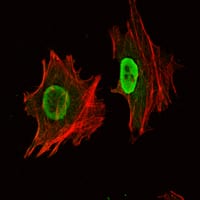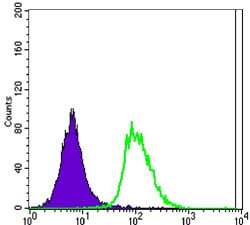


| WB | 1/500 - 1/2000 | Human,Mouse,Rat |
| IF | 咨询技术 | Human,Mouse,Rat |
| IHC | 咨询技术 | Human,Mouse,Rat |
| ICC | 1/200 - 1/1000 | Human,Mouse,Rat |
| FCM | 1/200 - 1/400 | Human,Mouse,Rat |
| Elisa | 1/10000 | Human,Mouse,Rat |
| Aliases | OCT3; OCT4; OTF3; OTF4; OTF-3; Oct-3; Oct-4; MGC22487; POU5F1 |
| Entrez GeneID | 5460 |
| clone | 7E7 |
| WB Predicted band size | 45kDa |
| Host/Isotype | Mouse IgG1 |
| Antibody Type | Primary antibody |
| Storage | Store at 4°C short term. Aliquot and store at -20°C long term. Avoid freeze/thaw cycles. |
| Species Reactivity | Human |
| Immunogen | Synthesized peptide derived from internal of human Oct4. |
| Formulation | Ascitic fluid containing 0.03% sodium azide. |
+ +
以下是关于Oct-4抗体的3篇参考文献及其摘要概括:
---
1. **文献名称**: *The homeoprotein Nanog is required for maintenance of pluripotency in mouse epiblast and ES cells*
**作者**: Mitsui, K. et al.
**摘要**: 本研究揭示了Oct-4与Nanog蛋白协同维持胚胎干细胞(ES细胞)多能性的机制。通过Oct-4抗体的免疫沉淀实验,发现Oct-4直接调控Nanog的表达,二者共同抑制分化相关基因,是干细胞自我更新的关键转录因子。
2. **文献名称**: *Germ cell tumors express the embryonic pluripotency marker OCT4/POU5F1*
**作者**: Jones, T.D. et al.
**摘要**: 文章利用Oct-4抗体对生殖细胞肿瘤(如精原细胞瘤)进行免疫组化分析,发现Oct-4蛋白在肿瘤细胞中高表达,提示其可作为诊断标记物,并为生殖细胞肿瘤的干细胞起源理论提供依据。
3. **文献名称**: *Quantitative expression of Oct-4 defines differentiation, dedifferentiation or self-renewal of ES cells*
**作者**: Niwa, H. et al.
**摘要**: 通过Oct-4抗体的定量检测,证明Oct-4蛋白表达水平对胚胎干细胞的命运起决定性作用:过高或过低分别导致自发分化或去分化,强调其在多能性维持中的精确调控作用。
---
**备注**:Oct-4(POU5F1)是干细胞与发育生物学领域的核心蛋白,其抗体广泛应用于多能性研究及癌症标志物检测。上述文献涵盖分子机制、诊断应用及功能验证,代表该抗体的关键研究方向。
The 4-Oct antibody, commonly referred to as anti-Oct-4 antibody, targets the Octamer-binding transcription factor 4 (Oct-4), a pivotal protein encoded by the *POU5F1* gene in humans. Oct-4 is a member of the POU-domain transcription factor family and plays a critical role in maintaining pluripotency and self-renewal in embryonic stem cells (ESCs) and induced pluripotent stem cells (iPSCs). It regulates the expression of genes essential for early embryonic development and cellular reprogramming.
Antibodies against Oct-4 are widely used in stem cell research, cancer biology, and regenerative medicine to identify and characterize pluripotent cells. In cancer studies, Oct-4 expression is linked to germ cell tumors and某些 cancers with stem-like properties, making it a potential diagnostic or prognostic marker. However, specificity challenges exist due to splice variants (e.g., Oct-4A vs. Oct-4B) and pseudogenes, necessitating validation via controls like knockout cell lines.
These antibodies are employed in techniques like immunohistochemistry, flow cytometry, and Western blot. Their applications extend to quality control in iPSC generation and studying mechanisms of cellular differentiation. Despite their utility, variations in antibody clones (e.g., C30A3. 9E2) may yield differing results, emphasizing the need for context-specific validation. Overall, Oct-4 antibodies remain indispensable tools for exploring pluripotency and disease mechanisms.
×